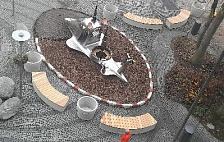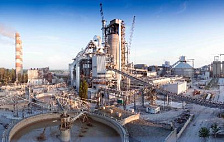One of the world’s largest cement manufacturers is pressing ahead with plans to build the UK’s first net-zero cement factory at a facility in North Wales.
Hanson, which is part of the global HeidelbergCement Group, is aiming to capture up to 800,000 tonnes of CO2 per year at its cement plant in Padeswood, near Mold (pictured).
The site is set to undergo a £400m upgrade to implement carbon-capture technology in the coming years. Speaking to Construction News, Hanson’s head of process and sustainability, Iain Walpole, said the upgraded plant would be able to combine low-carbon cement with carbon capture to ensure zero-net emissions from its production.
He said: "The whole concept of the Padeswood project was to make net-zero cement. So almost every little bit of calculation we've done, we have asked ourselves 'what does that do to the net-zero balance?'
"If you replace the [Portland] cement component with GGBS [ground granulated blast-furnace slag, which is a low-carbon cement], then obviously that brings the CO2 per cubic metre of concrete down; this project is making the bit that is left behind net-zero."
Often, GGBS cement and carbon capture and storage (CCS) are considered as different, competing solutions to the same problem. However, the Hanson site aims to utilise the low-carbon qualities of GGBS, which can cut up to 90 per cent of carbon emissions, while also ensuring that the remaining 9-10 per cent is eliminated.
The Padeswood site will tap into a now-depleted gas reserve in the Irish Sea to store the emissions. The location of Padeswood, near the HyNet pipeline that connects the gas fields off the Liverpool coast, makes it uniquely able to capture and store carbon without the need for a large amount of additional infrastructure.
Walpole said: "Basically, all the CO2 we get from our plants will go down about an 8 kilometre pipeline from a plant to the main [HyNet] line. And then it's about 20 to 30 kilometres on to the Liverpool Bay gas fields.
“The gas fields are just about coming to end of their life now. So it all fits together really nicely, timing-wise. The gas is coming to an end; they've got an asset they need to reuse, which makes the project so unique.”
The CCS project will include carbon capture and compression, which will see CO2 gas fixed with a binder, concentrated into a single gas and then transferred into the pipeline. Once inside, gas will be compressed to 40-bar atmospheric pressure, which is enough to ensure it travels back into the natural gas reserves.
The firm aims to produce net-zero carbon cement by 2030 or earlier. For that to become a reality, construction work will need to begin in 2024 and wrap up by 2027.
The deadline is dictated by government initiatives to deliver on the UK’s 2050 net-zero goal.
Walpole said: "Government funding requires us to be commercially operational by 2027. If you expect us to have a three-and-a-half-year build programme, that brings us to 2024. So we have two years to get the planning permissions in place and the funding organised, and so on.
“So it’s a really short timescale we’re working to now. This is going to be the first of its kind [in the UK] and it's a proof of concept.”
Hanson has up to eight projects on the go globally, with sites in Norway having progressed more than the Mold factory. However, the UK government’s requirements mean that the Padeswood factory is likely to have an accelerated timetable of development compared with some that are currently at the feasibility stage.
When operational, the factory will aim to save up to 800,000 tons of CO2 per year. With the gas fields in the Irish Sea capable of storing millions of tons of CO2, the project has a long shelf-life.
Walpole said: “There is a group-level commitment to getting to capturing 10 million tons of CO2 by 2030. There are something like 80 years [of capacity] at 10 million tonnes a year in the current field. Storage capacity isn’t something we have to worry about.”








